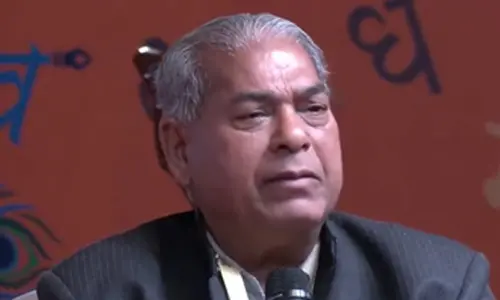Doubling farmers income by 2022 - the way ahead

Agriculture continues to be one of the largest livelihood and employment generating sector in the country
Agriculture continues to be one of the largest livelihood and employment generating sector in the country, with over 50 per cent of the population deployed in it.
Its contribution to India's 2017-18 GDP, however, was less than proportionate at 17-18 per cent. In a bid to remedy this situation, the government has set itself the target of doubling farmers' income by 2022.
Some of the key levers for achieving this include:
♦ Diversifying towards high-value crops.
♦ Increasing productivity through adoption of technology.
♦ Increasing cropping intensity.
♦ Securing better trade terms for farmers.
♦ Redeployment of surplus manpower engaged in farming to non-farm and subsidiary activities.
The interim Budget 2019-20 has already provided for increased outlays on schemes like PM-Kisan, price support, agriculture mechanisation, the Green Revolution, etc., which are targeted at these enablers, while total allocation across Central Sector Schemes and Centrally Sponsored Schemes in agriculture has doubled from Rs 67,800 crore to Rs 129,550 crore.
Some additional measures which may be considered as part of the final Budget 2019-20 are:
♦ Suitable policies for ensuring convergence at the ground level, backed by suitable institutional mechanisms for coordinated implementation, of related schemes, run by other ministries, eg the National Rural Livelihood Mission run by the Ministry of Rural Development, etc
♦ Extending the benefits of the Credit Guarantee Fund scheme (for collateral-free lending) to farmer producer organisations (FPOs), beyond those incorporated under the Companies Act and having a minimum of 500 individual shareholders, as a large number of FPOs are registered as cooperatives with fewer than 500 members.
♦ With livestock productivity another lever with the potential of augmenting farmers' income, the interim budget's proposed Rs 2,200 crore outlay on such "White Revolution" may need to be re-evaluated.
Infrastructure financing
With an estimated Rs 50 lakh crore needed to meet India's infrastructure requirements till 2022, infrastructure financing is key to achieving the country's economic aspirations.
With the interim budget 2019-20 allocating around Rs 4.56 lakh crore, but, given the need to meet fiscal deficit targets, the need to attract financing from non-government sources becomes important.
Key issues which need to be addressed include:
♦ Reducing dependence on bank financing and increased participation of long-term financiers like pension, insurance, and sovereign wealth funds, thereby addressing issues of asset liability mismatches and increased risk of default.
♦ Mitigating high risk profile during the initial period of a typical infrastructure project due to delays & uncertainties in procuring land, obtaining regulatory approvals etc. which impact credit rating and deter private investment.
♦ Inadequate depth of the infrastructure/corporate bond market which, in turn, impacts the ability of infrastructure companies to raise resources, due to a variety of factors like regulations limiting investments from pension funds/insurance companies.
For strengthening initiatives like announcement of the Infrastructure Investment Trust guidelines by the SEBI in September 2015 and the Insolvency & Bankruptcy Code, 2016 and deepening the infrastructure finance market further, the final Budget 2019-20 may consider the following:
♦ Mandating the Department of Economic Affairs to develop a consolidated strategy for blended financing of infrastructure projects in different sectors of the economy in consultation with the respective Ministries/Departments, and aligning it with key SDG goals.
♦ Extending the definition of CSR expenditure to include participation by corporates in augmenting or developing infrastructure related to health, education, etc., including projects/initiatives leveraging technology. A single window mechanism for granting CSR status to the contribution/investment made by the corporate should also be set up.
♦ Exploring whether a sub-limit of, say, 5 per cent could be created for pension funds/insurance companies' investment in infrastructure instruments rated BBB, within the original cap of 15 per cent.
♦ Augmenting credit enhancement facilities available for infrastructure projects beyond the facility provided by IIFCL through suitable fiscal incentives to large global infrastructure financiers.
♦ Introducing regulatory and fiscal measures to incentivize setting up of sector-specific infrastructure financing platforms like NIIF-Roadis, which would help pooling projects of different sizes and different stages of maturity to improve overall risk profile and facilitate private sector investment.
Ease of Living
One of the key focus areas for the current government is increasing ease of living of citizens. To enable a clear identification of underlying issues, it is important to separately assess the two important constituents of the population - urban and rural.
However, there are a set of common enablers which are likely to significantly impact ease of living across both these categories. These include:
♦ Adequate physical connectivity in the form of road/railway network etc. both for external, and internal, connectivity of the city/village.
♦ Dwelling unit/housing which meets minimum standards on ownership or rental basis.
♦ Availability of basic amenities/facilities like electricity, water, sanitation, waste collection etc. at the household level.
♦ Minimum standards of healthcare and education.
♦ Access to livelihood opportunities for sustainable income generation.
♦ Citizen-friendly and responsive governance & administration, with physical touchpoints only, when absolutely necessary.
Let us now look at the specific ease of living prerogatives for urban and rural India.
Urban
Apart from the measures in the interim budget on key urban sector schemes like the Swachh Bharat Mission (Urban), the Prime Minister Awas Yojana, and the Smart Cities Mission, the following additional measures may be considered in the final budget:
♦ Separate budgetary support for fast-tracking adoption of city-level technology platforms and innovation eco-systems like the India Urban Data Exchange and National Urban Innovation Stack in other cities.
♦ Launching a National Urban Mobility Mission to comprehensively address all related issues ranging from transit-oriented planning to facilitating set up of multi-modal mobility platforms to meet public transit requirements in an environment-friendly manner. This can leverage the existing allocation of Rs 18,000 crore towards MRTS/Metro projects in the interim budget 2019-20.
♦ Extending the right set of fiscal concessions (like considering any investment in such initiatives as contribution towards CSR) to the private sector for involvement in leveraging existing platforms and eco-systems available with them for public good, backed by suitable regulatory safeguards.
♦ Setting an urban infrastructure financing agency both at the state and city level, wherever it does not exist. Government assets like land can then be vested in this entity, supplemented by escrow of quality cash flows receivable for urban services, to enable it to raise external resources on commercial terms. The initial seed capital for this agency can be provided in the budget.
♦ With the city-level SPV essentially being involved in discharging some functions of the city corporation/urban local body, requisite exemptions under the GST Act and other related provisions may be extended to it.
♦ For financial sustainability, a suitable regulatory framework for transparently determining the cost of providing water together with a tariff structure which enables cross subsidization towards maximizing cost recovery may be considered. This would also necessitate separating the roles of service provider and regulator, as in the electricity sector.
Rural Development
Some key considerations for the final Budget 2019-20 are:
♦ A specific scheme for providing piped water connections at the household level is an immediate priority. The outlay on any such scheme is likely to be in excess of Rs 30,000 crore annually
♦ Leveraging the existing private sector health and education sector facilities/eco-systems through technology-enabled initiatives like telemedicine and distance learning to leapfrog implementation, particularly for Health & Wellness Centres under Ayushman Bharat, village level primary schools, etc. These can be covered as CSR efforts.
♦ An immediate need for extending other technology-enabled initiatives like land record digitisation, etc., at the village, or the cluster, level for streamlining citizen services.
♦ Suitable mechanisms for ensuring convergence of all the schemes at the village or cluster level and single-point monitoring for effective implementation.
(Arindam Guha is a Partner at Deloitte India)
















